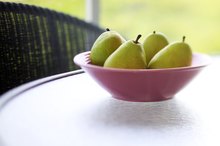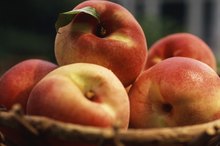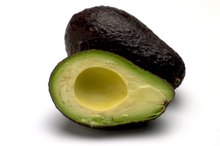What does fact checked mean?
At Healthfully, we strive to deliver objective content that is accurate and up-to-date. Our team periodically reviews articles in order to ensure content quality. The sources cited below consist of evidence from peer-reviewed journals, prominent medical organizations, academic associations, and government data.
The information contained on this site is for informational purposes only, and should not be used as a substitute for the advice of a professional health care provider. Please check with the appropriate physician regarding health questions and concerns. Although we strive to deliver accurate and up-to-date information, no guarantee to that effect is made.
Fruits That Raise Blood Sugar
Fruits, like most foods, contain carbohydrates that can raise your blood sugar. However, fruit also carries with it an abundance of healthy vitamins and minerals as well as fiber, which are part of a well-balanced diet. Understanding the benefits of fruit, as well as which fruits can drastically increase your blood sugar, is all part of ensuring blood-glucose control.
Sugars in Fruits
Most fruits contain the sugar fructose. Fructose is a type of carbohydrate called a monosaccharide that consists of a single sugar molecule, and one of the most common sugars found in nature. Most fruits also contain fiber, another carbohydrate or polysaccharide that's indigestible but has many health benefits. Fruits also contain pectin, which is a soluble fiber, and cellulose, an insoluble fiber.
- Most fruits contain the sugar fructose.
- Most fruits also contain fiber, another carbohydrate or polysaccharide that's indigestible but has many health benefits.
Glycemic Index of Fruits
Does Fruit Make Your Blood Sugar Go Up?
Learn More
Since fruits contain carbohydrates, most fruits will increase your blood sugar. However, some can affect it more than others. A good way to determine a food's effect on your blood sugar is to know its glycemic index. The glycemic index is a rating given to food, indicating how quickly and drastically will increase your blood glucose 3. The scale ranges from zero to 100; the higher a food's score on the glycemic index, the higher and faster it will raise your blood sugar 3. If a food is between 0 and 55, it is considered a low-glycemic food. From 56 to 69, it's considered a moderate glycemic food, and from 70 to 100, it is a high-glycemic food. Glycemic load is another measure of a food's impact on blood sugar that takes into account its glycemic index relative to its content of all forms of carbohydrate, including fiber. For example, watermelon has a high-glycemic index but a low glycemic load because it raises blood sugar slowly. Fruits that have a moderately high glycemic effect include bananas, pineapple and raisins. Low-glycemic fruits are apples, oranges, mangoes and grapefruit.
- Since fruits contain carbohydrates, most fruits will increase your blood sugar.
- If a food is between 0 and 55, it is considered a low-glycemic food.
Carbs and Fruit
According to the "Cecil Essentials of Medicine," diabetics should limit their intake of carbohydrates to 15 g per meal. This is equal to 1/2 cup of frozen fruit, 3/4 to 1 cup of melon or berries and 1/3 to 1/2 cup of fruit juice. Dried fruits, like raisins or cherries, can contain 25 g of carbs in just 2 tbsp.
Benefits of Fruit
Glycemic Index of Peaches
Learn More
The fiber content of fruit may be helpful in limiting the effect that fruit sugar has on your blood glucose. Eating fiber with a food lowers its glycemic effect. A high glycemic index means a spike in blood glucose, while a low-glycemic index food results in a moderate rise over a prolonged time. Fiber slows the digestion of foods and also blocks the absorption of sugars all at once. These combined factors result in a moderate rise in blood sugar over a significant amount of time. In addition, fruit offers an array of vitamins and minerals, so don't skip your intake of fruit just because you think it contains too much sugar.
- The fiber content of fruit may be helpful in limiting the effect that fruit sugar has on your blood glucose.
- A high glycemic index means a spike in blood glucose, while a low-glycemic index food results in a moderate rise over a prolonged time.
Related Articles
References
- "Nutrition: Concepts and Controversies"; Frances Sizer and Eleanor Whitney; 2004
- American Diabetes Association; Fruits; 2011
- Mendosa.com; The Glycemic Index; David Mendosa; August 2002
- Harvard School of Public Health: Carbohydrates and the Glycemic Load
- Mendosa.com; Revised International Table of Glycemic Index (GI) and Glycemic Load (GL) Values — 2008; David Mendosa; December 2008
- Ojo O, Ojo OO, Adebowale F, Wang XH. The effect of dietary glycaemic index on glycaemia in patients with type 2 diabetes: A systematic review and meta-analysis of randomized controlled trials. Nutrients. 2018;10(3):373. Published 2018 Mar 19. doi:10.3390/nu10030373
- Glycemic Index and Diabetes. American Diabetes Association
- Search for the Glycemic Index. The University of Sydney
- Zeevi D, Korem T, Zmora N, et al. Personalized Nutrition by Prediction of Glycemic Responses. Cell. 2015;163(5):1079-1094. doi:10.1016/j.cell.2015.11.001+
- Sacks FM, Carey VJ, Anderson CA, et al. Effects of high vs low glycemic index of dietary carbohydrate on cardiovascular disease risk factors and insulin sensitivity: the OmniCarb randomized clinical trial. JAMA. 2014;312(23):2531-41. doi:10.1001/jama.2014.16658.
- Vega-lópez S, Venn BJ, Slavin JL. Relevance of the Glycemic Index and Glycemic Load for Body Weight, Diabetes, and Cardiovascular Disease. Nutrients. 2018;10(10). doi:10.3390/nu10101361
- Glycemic Index Database. University of Sydney. Updated October 13, 2020
- Eleazu C. O. (2016). The concept of low glycemic index and glycemic load foods as panacea for type 2 diabetes mellitus; prospects, challenges and solutions. African health sciences, 16(2), 468–479. doi:10.4314/ahs.v16i2.15
- Foster-Powell, Kaye, Holt, Susanna and Brand-Miller, Janette. "International table of glycemic index and glycemic load values: 2002." American Journal of Clinical Nutrition. 76,:1: 5-56 (2002).
- International Carbohydrate Quality Consortium, Jenkins, D. J., Willett, W. C., Astrup, A., Augustin, L. S., Baer-Sinnott, S., … Wolever, T. M. (2014). Glycaemic index: did Health Canada get it wrong? Position from the International Carbohydrate Quality Consortium (ICQC). The British journal of nutrition, 111(2), 380–382. doi:10.1017/S0007114513003905
- Leroux, MarcusFoster-Powell, Kaye, Holt, Susanna and Brand-Miller, Janette. "International Table of Glycemic Index and Glycemic Load Values: 2002." American Journal of Clinical Nutrition. Vol. 76, No. 1, 5-56, (2002).
- Lui, S., Willett, WC, et al. "A prospective study of dietary glycemic load, carbohydrate intake, and risk of coronary heart disease in US women.." American Journal of Clinical Nutrition. 71(6):1455-61. (2001).
- Mayer-Davis, E.J., Dhawan, A et al. "Towards understanding of glycaemic index and glycaemic load in habitual diet: associations with measures of glycaemia in the Insulin Resistance Atherosclerosis Study.." British Nutrition Journal. 95(2):397-405. (2006).
- Sacks, F. M., Carey, V. J., Anderson, C. A., Miller, E. R., 3rd, Copeland, T., Charleston, J., … Appel, L. J. (2014). Effects of high vs low glycemic index of dietary carbohydrate on cardiovascular disease risk factors and insulin sensitivity: the OmniCarb randomized clinical trial. JAMA, 312(23), 2531–2541. doi:10.1001/jama.2014.16658
- Salmeron, J, Manson, JE, et al. "Dietary fiber, glycemic load, and risk of non-insulin-dependent diabetes mellitus in women.." Journal of the American Medical Association. 12;277(6):472-7. (1997).
- Vega-López, S., Venn, B., & Slavin, J. (2018). Relevance of the Glycemic Index and Glycemic Load for Body Weight, Diabetes, and Cardiovascular Disease. Nutrients, 10(10), 1361. doi:10.3390/nu10101361
- Zeevi, D. Korem N. et al. Personalized Nutrition by Prediction of Glycemic ResponsesCell. 163:(5):1079-94. November 2015.
Writer Bio
Laura Niedziocha began her writing career in 2007. She has contributed material to the Stoneking Physical Therapy and Wellness Center in Lambertville, N.J., and her work has appeared in various online publications. Niedziocha graduated from Temple University with a Bachelor of Science in exercise science. She also has her Associate of Arts in communications from the Community College of Philadelphia.









